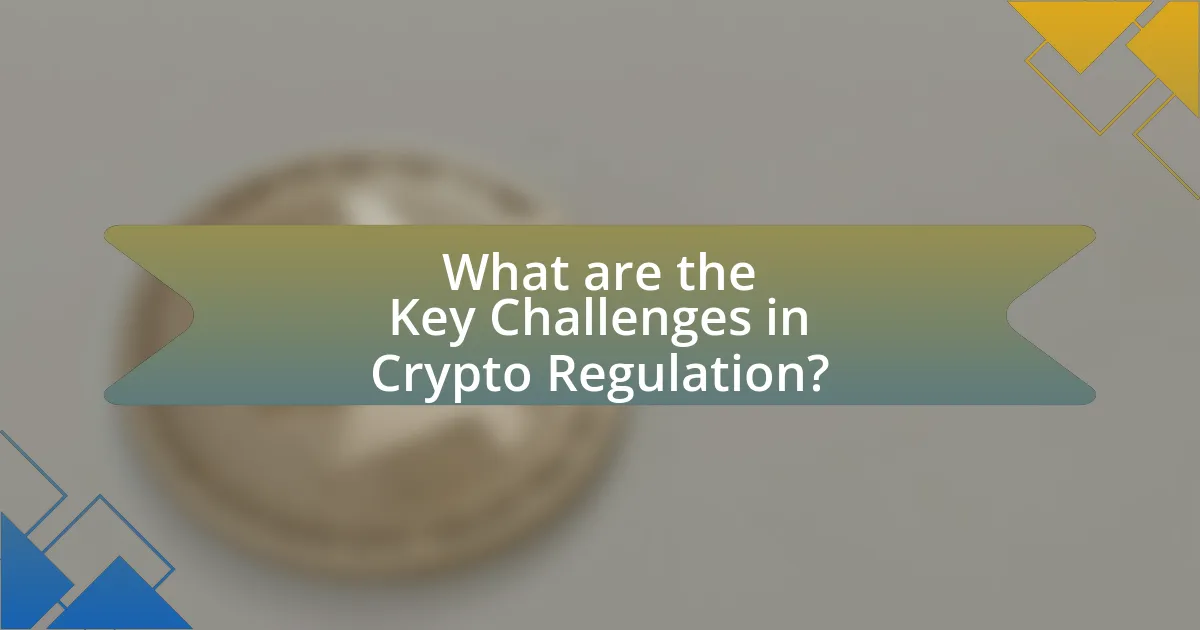The article focuses on future trends in cryptocurrency regulation, highlighting the shift towards comprehensive frameworks that prioritize consumer protection, anti-money laundering measures, and the integration of cryptocurrencies into existing financial systems. It examines global regulatory approaches, key frameworks such as the European Union’s Markets in Crypto-Assets (MiCA) regulation, and the role of international organizations like the Financial Action Task Force (FATF) in establishing standards. The article also discusses the challenges regulators face, the impact of regulation on market dynamics and adoption rates, and the potential risks of over-regulation. Additionally, it outlines emerging trends in compliance requirements and consumer protection laws, emphasizing the importance of proactive strategies for stakeholders in navigating the evolving regulatory landscape.

What are the Future Trends in Crypto Regulation?
Future trends in crypto regulation indicate a shift towards more comprehensive frameworks that prioritize consumer protection, anti-money laundering (AML) measures, and the integration of cryptocurrencies into existing financial systems. Regulatory bodies worldwide, such as the European Union with its Markets in Crypto-Assets (MiCA) regulation, are developing standardized rules to address the unique challenges posed by digital assets. This trend is supported by increasing global collaboration among regulators to create harmonized guidelines, as seen in initiatives by the Financial Action Task Force (FATF) to establish international AML standards for cryptocurrencies. Additionally, the rise of decentralized finance (DeFi) is prompting regulators to consider new approaches that balance innovation with oversight, ensuring that emerging technologies do not undermine financial stability.
How are governments approaching crypto regulation globally?
Governments globally are adopting varied approaches to crypto regulation, with some implementing strict frameworks while others favor a more lenient stance. For instance, the European Union is advancing comprehensive regulations through the Markets in Crypto-Assets (MiCA) framework, aiming to create a unified regulatory environment across member states. In contrast, countries like El Salvador have embraced Bitcoin as legal tender, reflecting a more progressive approach. Additionally, the United States is seeing a patchwork of regulations at both federal and state levels, with agencies like the SEC and CFTC actively working to define their roles in overseeing cryptocurrencies. This diversity in regulatory approaches highlights the ongoing debate among governments regarding the balance between fostering innovation and ensuring consumer protection.
What are the key regulatory frameworks being proposed?
The key regulatory frameworks being proposed for cryptocurrency include the European Union’s Markets in Crypto-Assets (MiCA) regulation, the United States’ proposed Digital Asset Market Structure and Investor Protection Act, and the Financial Action Task Force (FATF) guidelines on virtual assets. MiCA aims to create a comprehensive regulatory framework for crypto-assets within the EU, ensuring consumer protection and market integrity. The Digital Asset Market Structure and Investor Protection Act seeks to establish a clear regulatory framework in the U.S. for digital assets, focusing on investor protection and market stability. The FATF guidelines provide an international standard for combating money laundering and terrorist financing in the crypto space, emphasizing the need for transparency and compliance among virtual asset service providers.
How do different countries’ regulations compare?
Different countries’ regulations on cryptocurrency vary significantly, reflecting diverse approaches to governance and market control. For instance, the United States employs a fragmented regulatory framework where agencies like the SEC and CFTC oversee different aspects of crypto, leading to a complex compliance landscape. In contrast, countries like El Salvador have adopted a more progressive stance by recognizing Bitcoin as legal tender, promoting its use in everyday transactions. Furthermore, the European Union is working towards a unified regulatory framework through the Markets in Crypto-Assets (MiCA) proposal, aiming to create a comprehensive set of rules across member states. These variations illustrate how regulatory environments can influence market dynamics, investor behavior, and innovation in the crypto space.
What role do international organizations play in crypto regulation?
International organizations play a crucial role in crypto regulation by establishing frameworks and guidelines that promote consistency and cooperation among countries. These organizations, such as the Financial Action Task Force (FATF) and the International Monetary Fund (IMF), provide recommendations for anti-money laundering (AML) and combating the financing of terrorism (CFT) that member countries are encouraged to adopt. For instance, the FATF’s 2019 guidance on virtual assets outlines how countries should regulate cryptocurrency exchanges and wallet providers to mitigate risks associated with illicit activities. This collaborative approach helps to harmonize regulatory standards globally, facilitating cross-border transactions and enhancing the integrity of the financial system.
How is the Financial Action Task Force influencing regulations?
The Financial Action Task Force (FATF) influences regulations by establishing international standards for combating money laundering and terrorist financing, which member countries are encouraged to adopt. The FATF’s recommendations, known as the FATF Recommendations, serve as a framework that guides nations in developing their own regulatory measures. For instance, the FATF’s 2019 guidance on virtual assets and virtual asset service providers has prompted countries to implement specific regulations addressing the risks associated with cryptocurrencies. This has led to increased scrutiny and compliance requirements for crypto exchanges and service providers, thereby shaping the regulatory landscape globally.
What impact do global standards have on local regulations?
Global standards significantly influence local regulations by establishing benchmarks that local authorities often adopt to ensure compliance and competitiveness. For instance, the Financial Action Task Force (FATF) sets international standards for combating money laundering and terrorist financing, which many countries incorporate into their national laws. This alignment helps local jurisdictions enhance their regulatory frameworks, attract foreign investment, and maintain a level playing field in the global market. Additionally, adherence to global standards can facilitate cross-border cooperation and information sharing, further strengthening local regulatory effectiveness.
What are the potential impacts of regulation on the crypto market?
Regulation can significantly impact the crypto market by enhancing investor protection, increasing market stability, and fostering institutional adoption. Enhanced regulation can lead to greater transparency and accountability among crypto exchanges and projects, which may reduce fraud and market manipulation. For instance, the implementation of the European Union’s Markets in Crypto-Assets (MiCA) regulation aims to create a comprehensive regulatory framework that could boost investor confidence and attract institutional investors. Additionally, regulatory clarity can facilitate the entry of traditional financial institutions into the crypto space, potentially increasing liquidity and market capitalization. Historical examples, such as the regulatory responses following the 2017 ICO boom, demonstrate that clear regulations can lead to a more mature and resilient market.
How might regulation affect crypto adoption rates?
Regulation can significantly impact crypto adoption rates by providing a framework that enhances consumer trust and institutional participation. When governments implement clear regulations, it reduces uncertainty and risk associated with cryptocurrency investments, encouraging more individuals and businesses to engage with digital assets. For instance, a study by the Cambridge Centre for Alternative Finance found that regulatory clarity in jurisdictions like Switzerland and Singapore has led to increased adoption rates, with the number of active crypto users rising substantially in those regions. Thus, effective regulation can foster a more stable environment that promotes broader acceptance and integration of cryptocurrencies into the mainstream economy.
What are the risks of over-regulation in the crypto space?
Over-regulation in the crypto space can stifle innovation and limit market participation. When regulatory frameworks become excessively stringent, they can deter startups and established companies from developing new technologies or services, leading to a stagnation in the industry. For instance, a report by the World Economic Forum highlights that overly restrictive regulations can push crypto businesses to relocate to more favorable jurisdictions, resulting in a loss of economic opportunities and talent in the original market. Additionally, over-regulation can create barriers to entry for individual investors, reducing overall market liquidity and participation. This can ultimately hinder the growth and adoption of blockchain technology and cryptocurrencies, as evidenced by the decline in new projects following the implementation of strict regulations in various countries.

What are the Key Challenges in Crypto Regulation?
The key challenges in crypto regulation include the rapid pace of technological innovation, the lack of a unified regulatory framework, and the difficulty in enforcing compliance across borders. The fast-evolving nature of cryptocurrencies often outstrips existing regulatory measures, making it hard for authorities to keep up. Additionally, the absence of a consistent global regulatory approach leads to regulatory arbitrage, where companies exploit differences in regulations between jurisdictions. Enforcement is further complicated by the decentralized and pseudonymous nature of many cryptocurrencies, which can hinder the identification of bad actors. These challenges necessitate ongoing dialogue among regulators, industry stakeholders, and policymakers to develop effective regulatory solutions.
What are the main obstacles regulators face in the crypto industry?
Regulators face several main obstacles in the crypto industry, including the rapid pace of technological innovation, the decentralized nature of cryptocurrencies, and the lack of a unified regulatory framework. The fast evolution of blockchain technology often outstrips existing regulations, making it challenging for regulators to keep up and effectively oversee the market. Additionally, the decentralized characteristics of cryptocurrencies complicate jurisdictional authority, as transactions can occur globally without a central governing body. Furthermore, the absence of a cohesive regulatory approach across different countries leads to inconsistencies and gaps in enforcement, which can hinder effective regulation and consumer protection. These challenges are underscored by the increasing complexity of financial products associated with cryptocurrencies, which further complicates the regulatory landscape.
How do technological advancements complicate regulation?
Technological advancements complicate regulation by introducing rapid changes that outpace existing legal frameworks. For instance, the emergence of decentralized finance (DeFi) platforms challenges traditional regulatory approaches, as these platforms operate without centralized control, making it difficult for regulators to enforce compliance. Additionally, innovations such as blockchain technology and cryptocurrencies create unique challenges in areas like consumer protection, anti-money laundering, and taxation, as existing laws may not adequately address the complexities of these technologies. The speed of innovation, coupled with the global nature of technology, further complicates jurisdictional issues, making it hard for regulators to coordinate effectively across borders.
What challenges arise from the decentralized nature of cryptocurrencies?
The decentralized nature of cryptocurrencies presents several challenges, including regulatory uncertainty, security vulnerabilities, and market volatility. Regulatory uncertainty arises because the lack of a central authority complicates the enforcement of laws and regulations, leading to inconsistent legal frameworks across jurisdictions. Security vulnerabilities are prevalent as decentralized systems can be susceptible to hacking and fraud, with incidents like the 2016 DAO hack resulting in the loss of $50 million worth of Ether. Market volatility is another significant challenge, as the prices of cryptocurrencies can fluctuate dramatically, exemplified by Bitcoin’s price dropping from nearly $64,000 in April 2021 to around $30,000 in June 2021. These challenges necessitate careful consideration in the development of future regulatory frameworks for cryptocurrencies.
How do regulatory challenges differ across regions?
Regulatory challenges differ across regions primarily due to variations in legal frameworks, economic conditions, and cultural attitudes towards cryptocurrency. For instance, the European Union has implemented comprehensive regulations like the Markets in Crypto-Assets (MiCA) framework, aiming for harmonization across member states, while the United States faces a fragmented regulatory landscape with different states adopting varying approaches. In Asia, countries like China have imposed strict bans on cryptocurrency transactions, contrasting with Japan’s proactive regulatory stance that recognizes cryptocurrencies as legal tender. These differences are influenced by each region’s economic priorities, technological adoption rates, and risk tolerance levels, leading to distinct regulatory environments that impact the development and adoption of cryptocurrency.
What unique issues do emerging markets face in crypto regulation?
Emerging markets face unique issues in crypto regulation primarily due to a lack of established legal frameworks and regulatory clarity. Many of these countries struggle with limited technological infrastructure, which hampers the effective implementation of regulations. For instance, according to a 2021 report by the International Monetary Fund, over 70% of emerging economies lack comprehensive regulatory guidelines for cryptocurrencies, leading to increased risks of fraud and market manipulation. Additionally, the volatility of local currencies often drives citizens to adopt cryptocurrencies as a hedge, complicating regulatory efforts aimed at maintaining monetary stability. This situation is further exacerbated by the varying levels of financial literacy among the population, making it challenging for regulators to educate users about risks and compliance.
How do developed countries address regulatory challenges differently?
Developed countries address regulatory challenges by implementing comprehensive frameworks that balance innovation with consumer protection. For instance, the European Union has introduced the Markets in Crypto-Assets (MiCA) regulation, which aims to create a unified regulatory environment across member states, ensuring that crypto assets are regulated consistently while fostering market growth. In contrast, the United States employs a more fragmented approach, with different states having varying regulations, leading to a patchwork of compliance requirements that can stifle innovation. This divergence highlights how developed nations prioritize regulatory clarity and adaptability to address the unique challenges posed by the rapidly evolving crypto landscape.
What are the implications of regulatory uncertainty for investors?
Regulatory uncertainty significantly impacts investors by increasing risk and volatility in the market. When regulations are unclear or inconsistent, investors face challenges in making informed decisions, which can lead to market instability. For instance, the lack of clear guidelines on cryptocurrency taxation or trading can result in sudden price fluctuations, as seen during regulatory announcements in various countries. This unpredictability can deter investment and lead to capital flight, as investors seek more stable environments. Furthermore, regulatory uncertainty can hinder innovation, as companies may delay or abandon projects due to fear of potential legal repercussions, ultimately affecting market growth and investor confidence.
How does uncertainty affect market volatility?
Uncertainty increases market volatility by causing investors to react unpredictably to potential risks. When there is uncertainty, such as regulatory changes in the cryptocurrency market, investors may sell off assets to mitigate perceived risks, leading to sharp price fluctuations. Historical data shows that during periods of regulatory announcements or geopolitical events, markets often experience heightened volatility, as seen in the cryptocurrency market during the SEC’s announcements regarding Bitcoin ETFs, which led to significant price swings.
What strategies can investors use to navigate regulatory risks?
Investors can navigate regulatory risks by diversifying their portfolios and staying informed about regulatory changes. Diversification reduces exposure to any single regulatory environment, while continuous monitoring of regulatory developments, such as changes in laws or guidelines from authorities like the SEC or CFTC, helps investors anticipate potential impacts on their investments. For example, a study by the Cambridge Centre for Alternative Finance indicates that regulatory clarity can significantly influence market stability and investor confidence, underscoring the importance of proactive engagement with regulatory trends.

What Can We Expect from Future Crypto Regulations?
Future crypto regulations are expected to focus on increased transparency, consumer protection, and anti-money laundering measures. Regulatory bodies worldwide, such as the U.S. Securities and Exchange Commission and the European Union, are actively working on frameworks that require cryptocurrency exchanges and projects to adhere to stricter compliance standards. For instance, the Financial Action Task Force has recommended that countries implement regulations that ensure cryptocurrency transactions are traceable and that exchanges conduct thorough customer due diligence. These developments indicate a trend towards a more regulated environment aimed at fostering trust and stability in the cryptocurrency market.
What trends are emerging in regulatory approaches to cryptocurrencies?
Emerging trends in regulatory approaches to cryptocurrencies include increased global collaboration, the establishment of clearer frameworks, and a focus on consumer protection. Regulatory bodies worldwide are beginning to work together to create harmonized standards, as seen in initiatives like the Financial Action Task Force’s guidelines, which aim to combat money laundering and terrorist financing in the crypto space. Additionally, countries such as the United States and the European Union are developing comprehensive regulations that clarify the legal status of cryptocurrencies and the obligations of exchanges and service providers. This shift towards transparency and accountability is further evidenced by the growing emphasis on protecting consumers from fraud and market manipulation, as regulators implement measures to ensure that investors are informed and safeguarded.
How are regulators adapting to technological innovations?
Regulators are adapting to technological innovations by implementing frameworks that address emerging technologies while ensuring consumer protection and market integrity. For instance, many regulatory bodies are developing guidelines specifically for cryptocurrencies and blockchain technology, recognizing their potential impact on financial systems. The Financial Action Task Force (FATF) has established standards for virtual asset service providers to combat money laundering and terrorist financing, which illustrates a proactive approach to regulation. Additionally, regulators are increasingly collaborating with technology firms to understand innovations better and create regulations that foster innovation while mitigating risks. This adaptive strategy is evident in the European Union’s Markets in Crypto-Assets (MiCA) regulation, which aims to provide a comprehensive regulatory framework for digital assets, balancing innovation with necessary oversight.
What new compliance requirements might be introduced?
New compliance requirements that might be introduced in the realm of cryptocurrency regulation include enhanced Know Your Customer (KYC) protocols, stricter Anti-Money Laundering (AML) measures, and comprehensive reporting obligations for digital asset transactions. These potential requirements are driven by increasing concerns over fraud, money laundering, and the need for consumer protection in the rapidly evolving crypto market. For instance, the Financial Action Task Force (FATF) has recommended that countries implement regulations that require virtual asset service providers to collect and share information about the originators and beneficiaries of transactions, which aligns with global standards for financial transparency.
How might consumer protection laws evolve in the crypto space?
Consumer protection laws in the crypto space are likely to evolve towards more stringent regulations that ensure transparency, security, and accountability for digital asset transactions. As the market matures and incidents of fraud and volatility increase, regulatory bodies such as the U.S. Securities and Exchange Commission (SEC) and the European Securities and Markets Authority (ESMA) are expected to implement clearer guidelines that define the responsibilities of crypto exchanges and issuers. For instance, the SEC has already begun classifying certain cryptocurrencies as securities, which subjects them to existing securities laws designed to protect investors. Additionally, the rise of decentralized finance (DeFi) platforms may prompt regulators to establish specific frameworks that address unique risks associated with smart contracts and automated trading systems. These developments indicate a trend towards comprehensive consumer protection measures that align with traditional financial regulations, aiming to safeguard investors in the rapidly evolving crypto landscape.
What measures are being proposed to safeguard investors?
Proposed measures to safeguard investors include enhanced regulatory frameworks, increased transparency requirements, and the establishment of investor protection funds. Regulatory bodies are advocating for stricter compliance standards for cryptocurrency exchanges to ensure that they operate with integrity and provide clear information about risks. Additionally, the implementation of mandatory disclosures regarding the financial health of crypto projects aims to inform investors better. Investor protection funds are being discussed to provide a safety net in case of fraud or insolvency, similar to those in traditional finance. These measures are designed to mitigate risks and foster a safer investment environment in the evolving cryptocurrency landscape.
How can regulations enhance trust in the crypto market?
Regulations can enhance trust in the crypto market by establishing clear guidelines that protect investors and promote transparency. When regulatory frameworks are implemented, they help to mitigate risks associated with fraud and market manipulation, which are prevalent in unregulated environments. For instance, the introduction of the Financial Action Task Force (FATF) guidelines has led to increased compliance among crypto exchanges, fostering a safer trading environment. Additionally, regulations can facilitate the integration of cryptocurrencies into the traditional financial system, as seen with the approval of Bitcoin ETFs in various jurisdictions, which further legitimizes the market and attracts institutional investors.
What best practices should stakeholders adopt in light of future regulations?
Stakeholders should adopt proactive compliance strategies to effectively navigate future regulations in the crypto space. This includes staying informed about regulatory developments, engaging with regulatory bodies, and implementing robust compliance frameworks that align with evolving legal standards. For instance, the Financial Action Task Force (FATF) has set guidelines that require crypto businesses to adhere to anti-money laundering (AML) and know your customer (KYC) regulations, which stakeholders must integrate into their operations to avoid penalties. Additionally, conducting regular audits and risk assessments can help stakeholders identify potential compliance gaps and address them promptly, ensuring they remain aligned with regulatory expectations.
How can businesses prepare for upcoming regulatory changes?
Businesses can prepare for upcoming regulatory changes by conducting thorough compliance assessments and staying informed about potential legislative developments. Regularly reviewing existing policies and procedures ensures alignment with current regulations, while engaging with industry associations can provide insights into anticipated changes. Additionally, investing in training for employees on compliance matters fosters a culture of awareness and readiness. According to a 2022 report by the World Economic Forum, proactive compliance strategies can reduce the risk of penalties by up to 30%, highlighting the importance of preparation in navigating regulatory landscapes.
What role can advocacy play in shaping future regulations?
Advocacy plays a crucial role in shaping future regulations by influencing policymakers and raising awareness about specific issues within the regulatory landscape. Through organized efforts, advocacy groups can present data, expert opinions, and case studies that highlight the potential impacts of proposed regulations on various stakeholders, including consumers, businesses, and the economy. For instance, the Blockchain Association has actively engaged with lawmakers to promote a regulatory framework that fosters innovation while ensuring consumer protection, demonstrating how advocacy can lead to more informed and balanced regulatory decisions.















